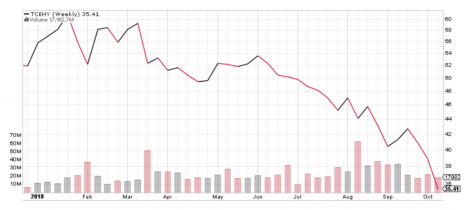If you consider yourself a savvy growth investor, you know that the market doesn’t hand out bargains, at least not very often. Stocks that make big price gains usually charge for the service with high volatility and high P/E ratios. The closest thing to a bargain I can think of right now (at least in the emerging markets, which is where I hang my hat) is Tencent Holdings stock (TCEHY), the Chinese messaging/all-things-online giant.
It looks to me like there is a massive divergence between how Tencent is doing as a company and how TCEHY is doing as a stock. And that divergence shows up most clearly in a straight comparison between the company’s fundamentals and the stock’s chart.
Tencent Holdings vs. Tencent Holdings Stock
Tencent boasts 803 million monthly active users (MAU) for its QQ messaging platform, with 709 million of those on smart devices. MAU for its combined Weixin and WeChat services total over a billion. The company has parleyed the dominance of its platform into a machine that mints money from online games, payments, subscriptions and sales, value-added services and advertising.
[text_ad use_post='129628']
Over the past five years, Tencent has booked revenue growth of 41% (2013), 29%, 28%, 40% and 57% (2017), with growth in Q1 and Q2 2018 coming in at 63% and 33%, respectively. After-tax profit margins have been in the mid-20% range.
Earnings have been a little depressed by the company’s massive program of investments in strategic partnerships and buyouts. That accounts for analysts’ estimate that earnings will grow by just 5% in 2018. But that number is likely very conservative, as the company booked 11% growth in Q1 and 24% in Q2. Analysts also forecast 37% EPS growth in 2019, and the firm has been pulling in its investing horns a little, reporting that it will increase its investment in game development and live game streaming, with the financing coming from liquidation of the company’s investments in Ele.me and Mobike.
Taken altogether, the fundamentals for Tencent are impressive any way you look at them.
So why, you may be asking, has Tencent Holdings stock etched a chart that looks like this since the beginning of 2018?
The simplistic answer is that TCEHY, despite being an over-the-counter stock, enjoyed a strong year of gains in 2017 that saw it run from 23 to 52 (and up to 61 in late January 2018 before the wheels came off). After a 165% gain, it’s reasonable for a growth stock to give a little back.
What’s not reasonable is for the stock of a very powerful company to plummet 42% (including a 9% pullback on October 10), with no bottom in sight.
So is TCEHY a growth stock bargain that’s only getting better, or the sharpest of falling knives that you’re better off avoiding?
TCEHY Today
My answer is that it’s probably both. TCEHY is now trading at a 30 P/E, which seems like a relative bargain to me given its record of growth and its prospects for the future. Despite its OTC status, which keeps many mutual funds from owning it, the stock enjoys a steadily increasing roster of institutional investors, now totaling 198, up from 94 a year ago. Tencent Holdings has a web of investments in the Chinese online world that promise continuing returns and big opportunities.
The problem is that the trade war between China and the U.S. is raging with no end in sight and there are tangible signs that it’s starting to hurt the Chinese economy. If China were to suffer a real kick to the kneecap of its economy, the blow would be felt in the online world as well as the manufacturing/export world.
What we need from Tencent Holdings stock is a bottom, and there’s no such thing in sight.
We’ll recognize it when it arrives, of course. One of the stock’s little bounces will find a ledge to sit on and selling volume will decrease. A period of sideways trading will set in, with little volume spikes on up days as the more aggressive growth investors get their bets in early.
When that happens, I will be ready to tell the subscribers to my Cabot Global Stocks Explorer advisory. We won’t get in at the absolute bottom, of course, that’s something that will be obvious only in hindsight. But we’ll be ready to step on the rising escalator once it proves that it’s serious about going up. If that sounds like a good idea to you, you can find out more by clicking here.
[author_ad]


